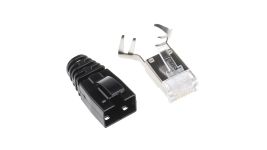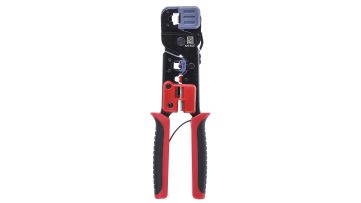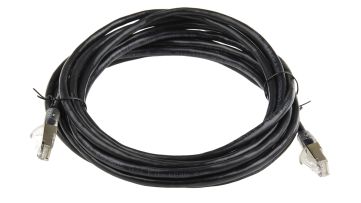A Guide to RJ45 Connectors
Find out more about RJ45 connectors and how to wire them in our comprehensive guide.

In this beginners’ guide to the various types of RJ45 connector for sale online, we will answer some basic FAQs about why and how these network connectors work the way they do. We will identify various options you might see and explain how to wire an RJ45 connector to an Ethernet cable.
What is an RJ45 Connector?
RJ45 network connectors are most commonly found at either end of an Ethernet (wired internet) connection. At first glance, they appear similar to the familiar telephone plugs and jacks which connect landlines to walls or switchboards. However, RJ45 connectors are typically slightly larger.
The term RJ45 connector is widely used today to describe both male RJ45 plugs and female RJ45 sockets. The plugs, sometimes called modular connectors, are usually found on the end of Ethernet cables. The sockets or jacks are generally embedded in the device that is being hooked up or mounted to a fixed wall panel.
Definition of an RJ45 Connector
Registered jacks are for telecoms network interfaces. Their job is to link various types of voice and data equipment either to a central hub or directly to each other.
In modern domestic and commercial environments, RJ45 connectors are primarily used for plugging an internet-enabled device directly into hardware such as a modem, router, or server. The connectors themselves are the modular sets of fittings at either end of the physical data connection (Ethernet cable) joining one networked device to another.
As previously mentioned, the term ‘RJ45 connector’ can broadly refer to both male and female versions of these jacks and plugs. In the case of Ethernet networking, the plug fixtures on cable ends are the RJ45 male parts, while the sockets found on the devices themselves are RJ45 female parts.
Technical RJ45 Definitions
Most standard Ethernet data cables have a core consisting of four twisted-pair wire strands, making eight individual wires in total. Male RJ45 plugs separate and correctly terminate these eight individual wires. In other words, RJ45 wiring is based on an 8P8C (8 position, 8 contact) configuration.
Standard RJ45 is defined as a mechanically-keyed variant on a generic 8P8C body. Mechanically keyed essentially means that RJ45 connectors also include an additional tab. This extra tab is designed to prevent them from being mated with any other socket standards which are visually similar, but electrically incompatible. It also prevents accidental disconnection.
For an RJ45 network connector to function properly, the eight Ethernet cabling wires must be inserted into the correct pinout locations on the male connector. With RJ45, this is done following either a T568A or T568B wiring standard. Each of these standards has its own colour-coded wiring convention, achieving two different forms of connectivity.
What is RJ45?
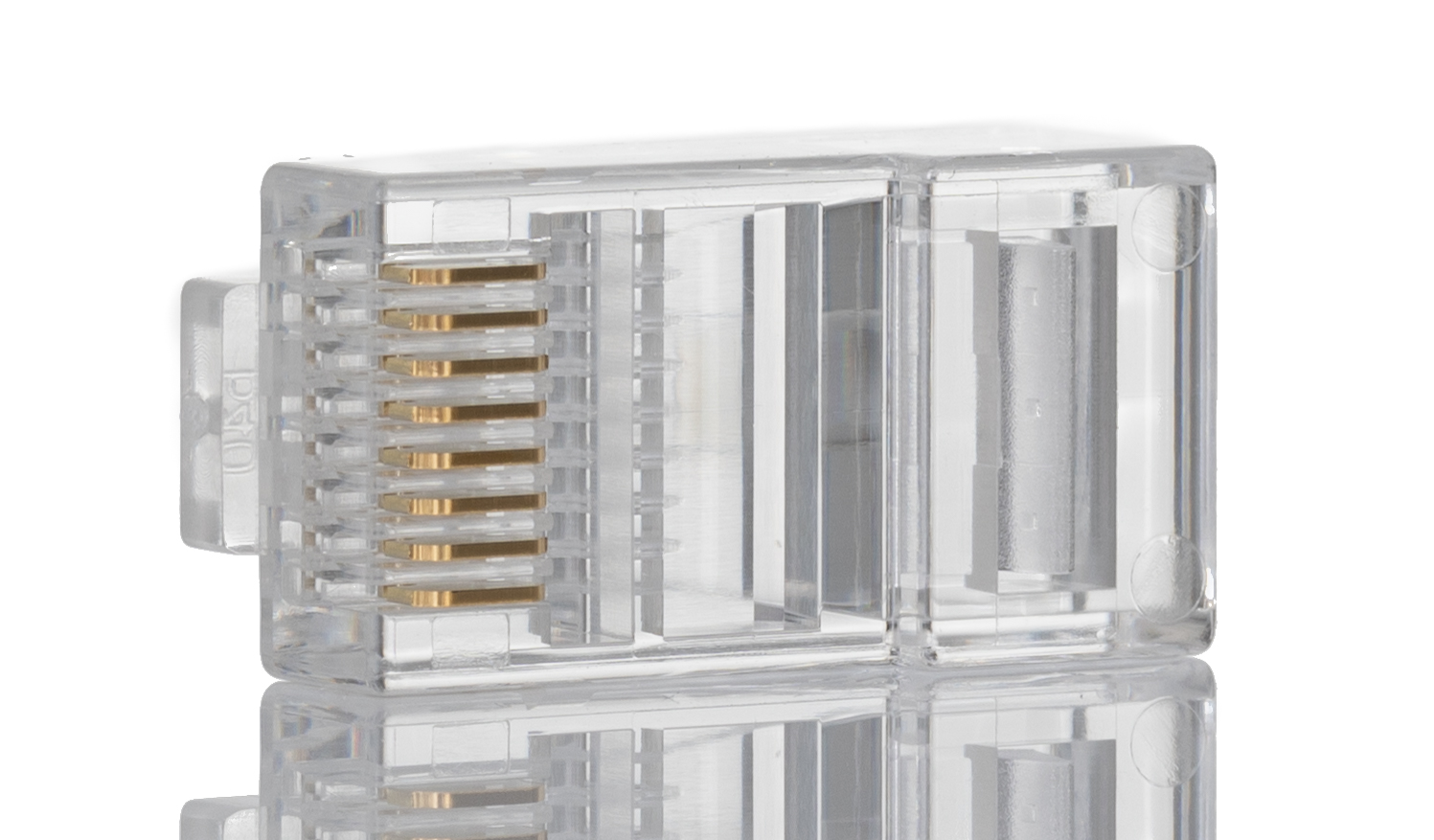
RJ45 stands for ‘Registered Jack 45’. This tells you that it is part of a universally standardised networking interface. These registration interfaces were designed in the 1970s to ensure full compatibility between telephone company hardware and consumer equipment. The newly standardised range of jacks and plugs were released as a series of miniature modular connectors – of which RJ45 is one type.
Referring to a registered jack used to specifically imply the standardised female sockets and their wiring (hence the term ‘jack’, meaning socket). However, this has gradually shifted over time. Today, RJ45 is widely used as a shorthand reference for both male and female components of the modular RJ45 connector system.
Wired Ethernet Connections and RJ45 Connectors
Wired Ethernet connections between devices are often preferred as a physical alternative to wireless or Wi-Fi networks. This is because wired Ethernet tends to provide a more reliable, stable, and interference-free connection. It also offers the potential for faster data transfer speeds than wireless in most cases and prevents interception of sensitive data by hackers.
Today, Ethernet networks are commonplace in both domestic and professional environments. A network is simply several interconnected devices that are capable of sharing data between one another. Home networks, for example, are usually based around a router or modem, connected to various other devices and sharing out data. This might include PCs and laptops, smart TVs, mobile phones, games consoles, media servers, printers, and so on. A domestic setup of this kind is an example of a LAN (Local Area Network). The name comes from the fact that all devices linked to it are close to the others, typically within the same building.
If all the devices on a given network can interconnect wirelessly, then there may not necessarily be any Ethernet or RJ45 cabling involved at all. However, when they are linked by a physical, wired connection for better speed and stability of data transfer, it is invariably some category of Ethernet cable that connects them. It will have a small plastic or metal plug fitting at both ends. Corresponding sockets on the respective devices will allow the plug to slot in easily, making a secure connection. These modular plug and socket fittings are commonly known as RJ45 connectors.
Types of RJ45 Connector
There are various RJ45 connector types available to buy, with the most important distinction being between the modular male and female versions. So, what are the different types of RJ45 connector, and how do you differentiate between them?
In short, plugs are male whereas jacks or sockets are female. The key role of plugs is to properly terminate the wires in an Ethernet cable. Conversely, the role of sockets is to transfer the electrical data signal through to the device it is being shared with. The two are designed to fit together securely to provide a solid connection – both physical and electrical.
Female RJ45 Connectors (RJ45 Socket)
RJ45 connector female parts are the recessed sockets, designed for a male RJ45 plug to be inserted into the socket. You will often see these connector sockets referred to as an RJ45 female jack, female RJ45 socket, or similar. They are typically embedded in the body of the device you are trying to connect up, or on wall and panel installations.
In the case of most consumer TVs, PCs, and tech hardware, the female RJ45 Ethernet socket can be found on the device’s I/O (in/out) connectivity panel. This is usually located at the rear of the device, along with various other sockets for HDMI cables and USB cables, for example.
Male RJ45 Connectors (RJ45 Plug)
RJ45 male connectors are the modular plug-in components found at either end of an Ethernet cable. They are most often made from clear, white, black or grey plastic, but they can also include a wider range of other colours and materials. Professional grade, high-quality male RJ45 connectors are sometimes shielded in metal. This helps to minimise the risk of EMI interference, improving the quality and stability of the data signal being transferred.
It is worth noting that you will not typically find Ethernet cables with one female RJ45 end and one male RJ45 end. If you need to extend a cable in this type of setup, as opposed to buying a longer one, you will typically need to use an RJ45 male-to-male adapter. This is usually a small linking module made from two female sockets facing in opposite directions.
Field RJ45 Connectors
A field RJ45 connector is simply a more rugged version of the RJ45 connector standard. Field RJ45 connectors are mainly used in applications where the wiring system will be exposed to dust, vibrations, water, or mechanical stress. The types of hazards that you will need to protect your network connection against will dictate which is the best version to buy. Field RJ45 connectors are available as both cable-cable interconnects and as panel-mounted sockets. They might incorporate various additional features for strength and durability.
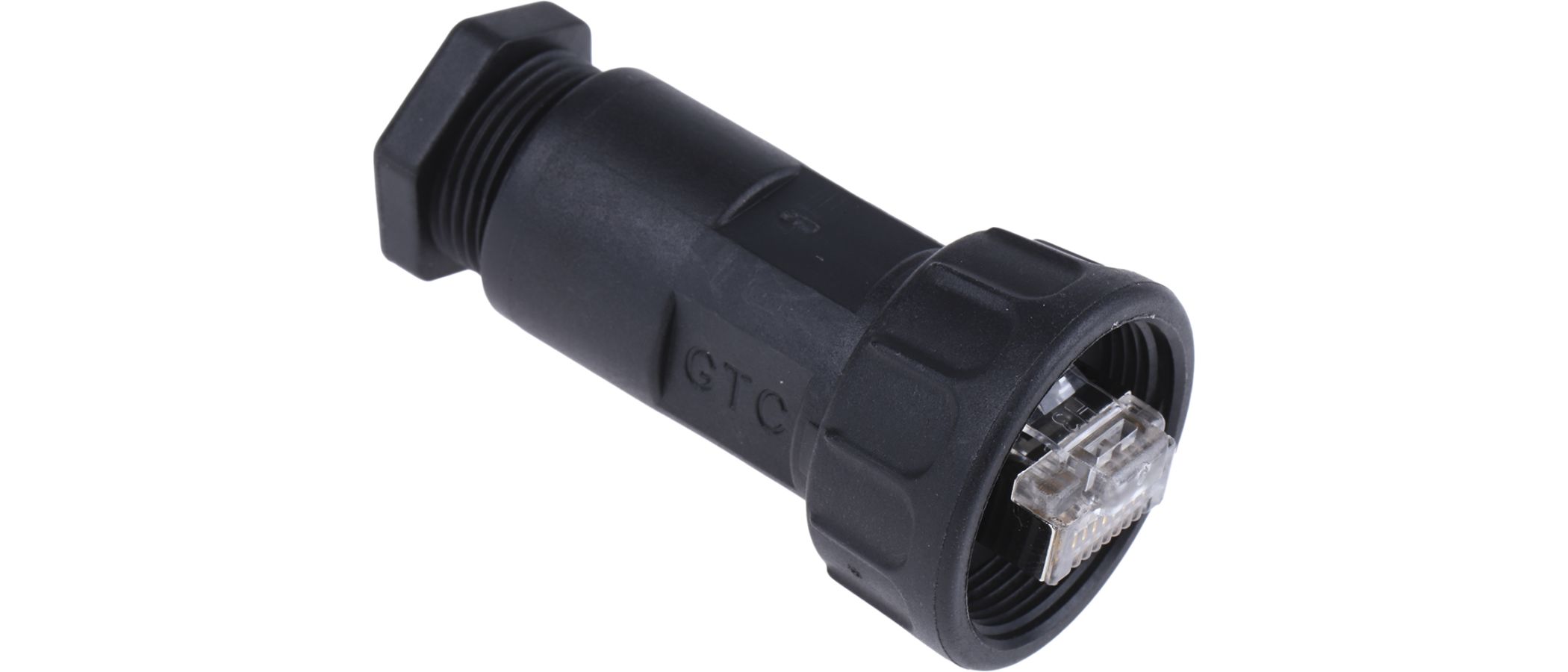
- Heavy environmental shielding (IP-rated against dust, dirt, moisture etc)
- Vibration shielding
- Mechanical stress relief at both the connector-cable and connector-socket interfaces
- Screw-terminated shields to transfer loads independently of the electrical connections
RJ45 plug connections are based on 8P8C cabling. The patch cable has eight colour-coded individual wires that must be crimped correctly with the connector.
T568A and T568B Wiring Conventions for RJ45
You should be aware that there are two types of electrical connection you can make when wiring an RJ45 plug to an Ethernet cable. The types that you make will depend on which wiring standard you use – T568A or T568B.
These determine the order in which the eight individual wires in Ethernet cables link to an RJ45 connector pinout. T568A is generally seen as the superior configuration as it offers wider backwards compatibility than other wiring schemes. However, T568B is more common, particularly in slightly older cables and equipment.
The two standards each have their own colour code, with the key difference being that the orange and green pairs are swapped around. You will need to make sure that you are using the correct wiring standard for the type of connection you are trying to make.
For the pin assignment according to T568A, arrange the wires as follows:
| Pin | 1 | 2 | 3 | 4 | 5 | 6 | 7 | 8 |
| Colour | White / Green | Green | White / Orange | Blue | White / Blue | Orange | White / Brown | Brown |
The pin assignment according to type T568B swaps pairs two and three. The correct pin assignment is as follows:
| Pin | 1 | 2 | 3 | 4 | 5 | 6 | 7 | 8 |
| Colour | White / Orange | Orange | White / Green | Blue | White / Blue | Green | White / Brown | Brown |
The correct standard will depend on whether you are using a straight-through cable (often called a patch cable) or a crossover cable. In most cases, you will be using patch cable, which has the same type of wiring standard at each end. Crossover cable is far less widely used and has a T568A connection at one end and a T568B connection at the other end.

Wiring an RJ45 Connector
Wiring your own male RJ45 plugs to the end of a suitable network communication cable requires just a few simple tools. Fixing a new connector is usually cheaper than replacing an entire Ethernet cable. Other reasons you may want to wire them yourself include:
-
Knowing how to wire an RJ45 connector plug means that you can cut your Ethernet cable to custom lengths. This is handy for neatly managing cables or creating very long runs
-
RJ45 plugs and sockets can be damaged by stress forces at connection points. This sometimes happens if a cable is too short or gets pulled or snagged. As a general rule, pressure on RJ45 connections should not exceed around 20lbs.
-
Although the polycarbonate plastic on most RJ45 connectors is fairly robust, it can eventually wear out or break. Inserting and removing connectors incorrectly can damage plugs or sockets. Frequent swapping between sockets can cause plugs to loosen over time. Impact can also cause an RJ45 connector to fail, crack, or detach
-
If you intend to make lots of cables, wiring them yourself can also be a considerable cost-saving measure
Ethernet Cable RJ45 Wiring Step-by-Step Guide
The tools and components you will need include:
-
An Ethernet network communication cable
-
RJ45 crimpable connectors for the category of cable you are using
Once you have established which wiring convention you need to use, complete your RJ45 wiring by following these basic steps:
-
If necessary, cut your cable to the required length with a cable cutter
-
Use your crimping tool to trim and tidy the cut ends of the cable you will be working on
-
Take a pair of wire strippers and remove about an inch of the cable jacket from the end. Make sure that you do not damage any of the internal wiring in the process
-
Untwist and separate the eight individual wire strands that make up the cable core. Flatten and straighten them out as much as possible
-
Arrange them side-by-side in a line. It is important to arrange them in the correct order by colour. For standard patch cabling, this is (L-R): white/orange, solid orange, white/green, solid blue, white/blue, solid green, white/brown, solid brown
-
Cut the wires straight across at the ends, around half an inch from the cable sleeve
-
Hold your male RJ45 connector plug with its contact pins pointing away from you and away from the cable wires, and its keyed tab (plug clip) facing downwards
-
Gently push the arranged wires through the body of the RJ45 plug, until they reach and touch the end of the connector where the pins are. Feed-in a half centimetre or so of the cable jacket too; this will provide a stronger and better-insulated connection. If the length of the wires prevents this, you will need to trim them a bit shorter
-
Once you have attached the connector according to the above steps, take your RJ45 crimping tool and use it to press down tightly on the connector around the cable. Tabs inside the connector will pierce and flatten the individual wires, forcing them into proper contact. Once you have crimped the wire around the connector in this way, that end of the cable is ready to be tested for use
Crimping tools are used to join or connect two components or pieces of material through compression forces. They work by squeezing the two parts together tightly enough to form a fairly permanent bond or seal. Different sorts of crimp tools have various additional functions along with this ability to compress and seal materials. Common examples include cutting, stripping, and bending.
An RJ45 crimping tool (sometimes called an RJ45 crimper or RJ45 connector tool) is used to attach the male plug connectors to the ends of a suitable cable. This is normally some category of Ethernet cable. Using an RJ45 crimp tool enables you to connect these components quickly and simply, for a fast and cost-effective fix or custom cable build.
Numerous options are available for buying crimp tools, including hand-operated crimp tools, electric crimp tools, hydraulic crimp tools, pliers, and ratchets. Handheld or manual crimp tools for RJ45 are among the simplest and most economical options to use.
There are numerous grades, referred to as categories, of RJ45 cable sold online. They are collectively known as Ethernet or network communication cables and are used to achieve high-speed data transfer connections.
Ethernet cable is constructed using a set of four twisted pair wires (eight wires in total). Some are shielded, but many Cat5 and Cat6 cables are unshielded. Generally speaking, the higher the category number, the greater the potential speed and capacity (data transfer rate) of the cable will be between directly-linked servers, switches, and network devices.
In the majority of standard domestic and office networks, cable grades like Ethernet Cat5e, Cat6, and Cat6a are among the most widely used. For more demanding situations, such as wired Gigabit Ethernet, higher categories such as Cat7 cable are preferred. It is also worth noting that the cables are backwards compatible.
The other important distinction when buying Ethernet cable is between straight-through or patch cable, and crossover cable. Straight-through or patch cable has the same type of wiring at both ends. This is the standard version used in most domestic environments (e.g. connecting PCs and devices to a network hub or router). Crossover cable has a T568A wiring connection at one end, and a T568B connection at the other end. It is generally used to link two computers directly together, without passing through an intermediary device or hub such as a router or network switch. However, this is rarely done nowadays.
Where to Next?
Wiring Colours Guide
What do the different electrical wiring colours refer to in the UK? Find out more in our wiring colours guide.
HDMI Cables Guide
Explore our complete HDMI cables guide and learn how they are used and what version is best for your application.
USB Cables Guide
Have you always wondered what is the difference between USB types? Read on to find out.
IP Ratings Guide
This comprehensive guide looks at what IP ratings are, how they are used, and what IP rated products are available.

